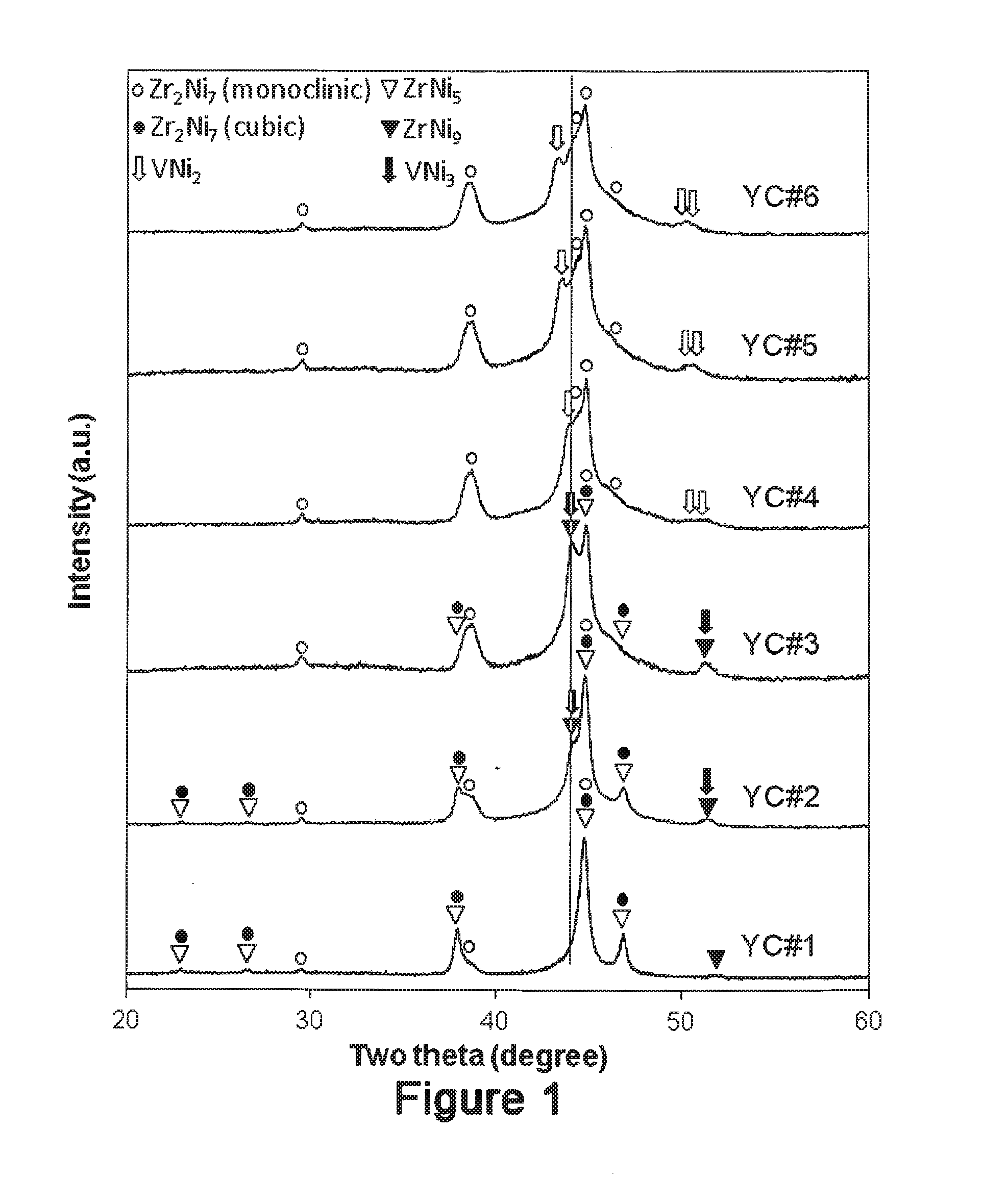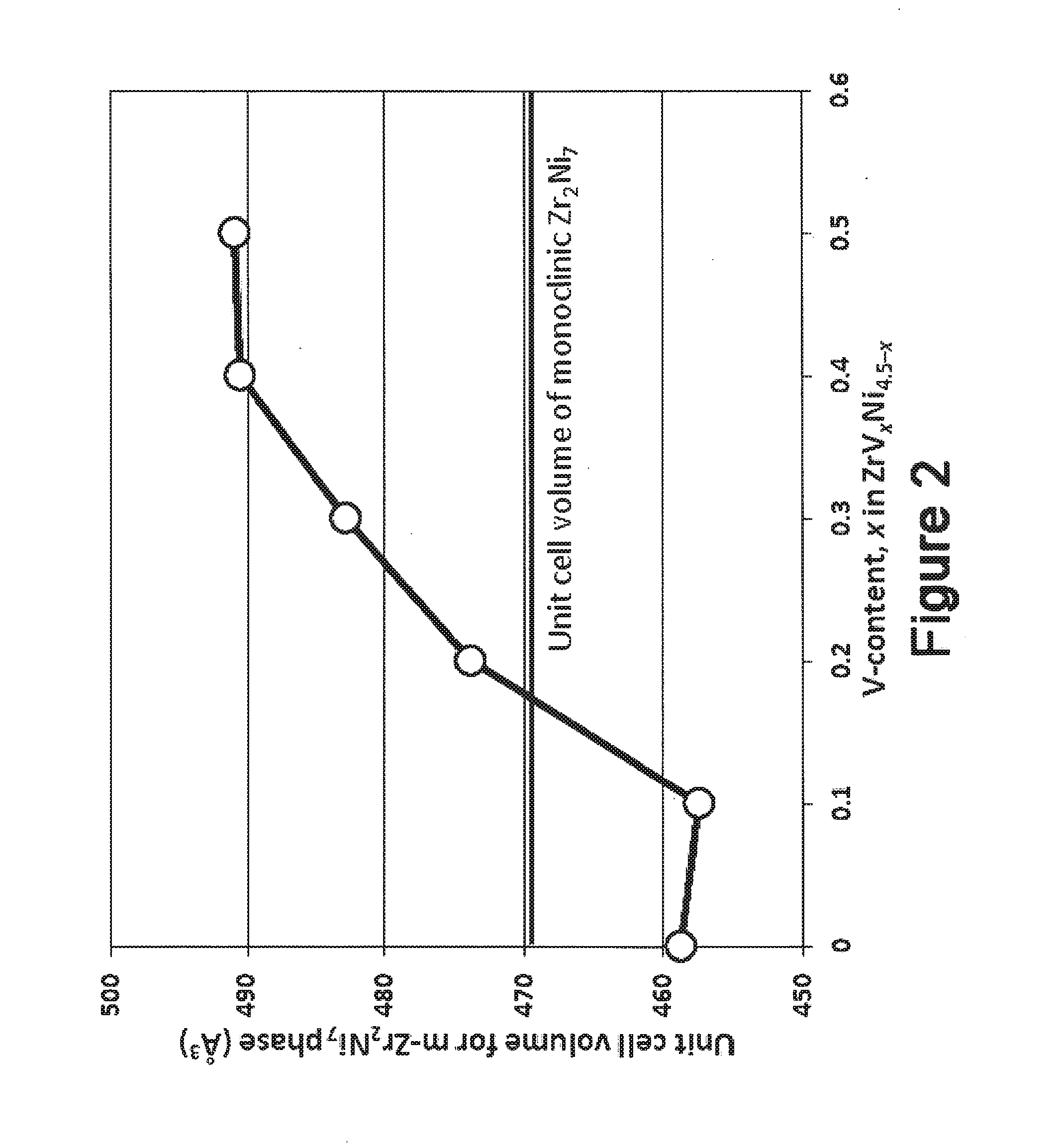Hydrogen storage alloy and negative electrode and ni-metal hydride battery employing same
a technology of metal hydride battery and negative electrode, which is applied in the field of nickel hydride batteries, can solve the problems of high densities of metallic inclusions embedded in surface oxide, low etc., and achieve the effect of improving one or both discharge capacity and surface exchange current density
- Summary
- Abstract
- Description
- Claims
- Application Information
AI Technical Summary
Benefits of technology
Problems solved by technology
Method used
Image
Examples
example 1
ZrVxNi4.5-x
[0026]The present invention comprises the use of V as a modifying element to improve the electrochemical properties of ZrNi5 alloy. In order to improve the high-rate performance of the transition metal-based metal hydride alloys, a series of ZrVxNi4.5-x (x=0.0, 0.1, 0.2, 0.3, 0.4, and 0.5) ternary metal hydride alloys with high Ni-content were studied. The main phase(s) of the alloy evolves from ZrNi5 and cubic Zr2Ni7 to monoclinic Zr2Ni7, ZrNi5 and ZrNi9, and then finally to monoclinic Zr2Ni7 only with increases in V-content. The secondary phase(s) evolves from monoclinic Zr2Ni7 and ZrNi9 to cubic Zr2Ni7 and VNi3 and then to VNi2. PCT results show incomplete hydriding using the current set-up (up to 1.1 MPa), low maximum gaseous phase hydrogen storage capacities (≦0.075 wt. %, 0.05 H / M), and large hysteresis. The maximum gaseous phase storage capacity decreases, in general, with the increase in V-content. In the half-cell test, 5 to 15 times higher equivalent hydrogen s...
example 2
ZrVxNi3.5-x
[0048]The structure, gaseous storage, and electrochemical properties of a series of ZrVxNi3.5-x (x=0.0 to 0.9) metal hydride alloys were studied. As V-content in the alloy was increased, the main Zr2Ni7 phase shifted from a monoclinic to a cubic structure, both ZrNi3 and ZrNi5 phase abundances decreased, equilibrium pressure increased, both gaseous phase and electrochemical storage increase and then decrease, and both the high-rate dischargeability and bulk diffusion constant increase. The measured electrochemical discharge capacity was higher than that measured in gaseous phase, and was explained by the synergetic effect from the secondary phase.
[0049]Ten alloys with V substituting for Ni at various levels (ZrVxNi3.5-x, x=0.0, 0.1, 0.2, 0.3, 0.4, 0.5, 0.6, 0.7, 0.8, and 0.9) were prepared by arc melting. A B / A ratio of 3.5 was kept constant. ICP results are consistent with the design within 3%. The ingots were not annealed in order to preserve the secondary phases, whic...
PUM
| Property | Measurement | Unit |
|---|---|---|
| open circuit voltage | aaaaa | aaaaa |
| diffusion coefficient | aaaaa | aaaaa |
| temperature | aaaaa | aaaaa |
Abstract
Description
Claims
Application Information
 Login to View More
Login to View More - R&D
- Intellectual Property
- Life Sciences
- Materials
- Tech Scout
- Unparalleled Data Quality
- Higher Quality Content
- 60% Fewer Hallucinations
Browse by: Latest US Patents, China's latest patents, Technical Efficacy Thesaurus, Application Domain, Technology Topic, Popular Technical Reports.
© 2025 PatSnap. All rights reserved.Legal|Privacy policy|Modern Slavery Act Transparency Statement|Sitemap|About US| Contact US: help@patsnap.com



